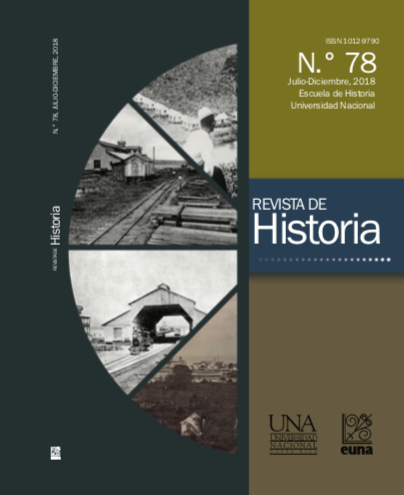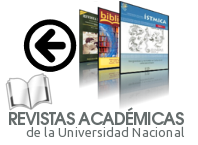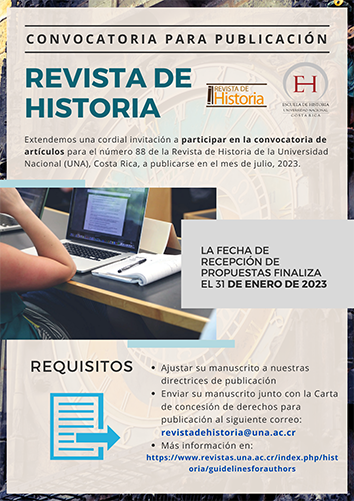Amazon and Petén: Two Regions Unsuitable for the Development of Civilization?
DOI:
https://doi.org/10.15359/rh.78.6Keywords:
Archaeology, Amazon, Peten, Agriculture, Long-Term Environmental Sustainability, HistoryAbstract
For most of the Twentieth century archeologists and ethnologists agreed to think that regions such as the Amazon in Brazil, Peten forest in Guatemala, Belice and southern Yucatan were areas where agricultural systems able to support large population centers with complex societies were not possible at pre-Columbian times. Their type of soils, vegetation and climate made this step in civilization almost unattainable. However, new findings and studies at the end of last century challenged this idea. New data and close examinations of old chronicles from Sixteenth and Seventeenth centuries probe that autochthonous populations inhabiting the Amazon as well as Peten forest managed to develop sophisticated and productive farming systems. These techniques could not only feed large populations but made also possible the rise of complex societies.
References
Adam Calvin Parker, “Evidence of Ancient Maya Agriculture in the Bajos Surrounding Tikal, Guatemala”, All Thesis and Dissertations (EE. UU.) 5784 (2015), URL: https://scholarsarchive.byu.edu/etd/5784
Alfred H. Siemens, “Prehispanic Agriculture Use of the Wetlands of Northern Belice”, en: Maya Subsistence: Studies in Memory of Dennis E. Puleston, Kent V. Flannery (ed.) (New York, EE. UU.: Academic Press, 1982).
Anna Curtenius Roosevelt, Moundbuilders of the Amazon: Geophysical Archaeology on Marajo Island, Brazil (San Diego, EE. UU.: Academic Press, 1991).
Antes de Orellana: Actas del 3er Encuentro Internacional de Arqueología Amazónica, Stéphen Rostain (ed.) (Quito, Ecuador: Instituto Francés de Estudios Andinos; Facultad Latinoamericana de Ciencias Sociales; Embajada de Estados Unidos, 2014).
Arthur Demarest, Ancient Maya: The Rise and Fall of a Rainforest Civilization (Cambridge, Inglaterra: Cambridge University Press, 2004).
Arturo Gómez-Pompa y Aandrea Kaus, “Taming the Wilderness Myth: Environmental Policy and Education are Currently Based on Western Beliefs about Nature Rather than on Reality”, BioScience, 42, n. 4 (abril, 1992), DOI: https://doi.org/10.2307/1311675
B. L. Turner y Charles H. Miksicek, “Economic Plant Species Associated with Prehistoric Agriculture in the Maya Lowlands”, Economic Botany (EE. UU.) 38, n. 2 (abril, 1984): 179-193, DOI: https://doi.org/10.1007/BF02858831
Betty J. Meggers, “Environmental Limitation on the Development of Culture”, American Anthropologist (EE. UU.) 56, n. 5 (octubre, 1954), URL: https://www.jstor.org/stable/663814
Betty J. Meggers, Amazonia:Man and Culture in a Counterfeit Paradise, edición revisada (EE. UU.: Smithsonian Institute, 1996).
Billie Lee Turner II, “The Development and Demise of The Swidden Thesis of Maya Agriculture”, en: Pre-Hispanic Maya Agriculture, D. Harrison y Billie Lee Turner II (eds.) (Albuquerque, EE. UU.: University of New Mexico Press, 1978).
Charles C. Mann, 1491: New Revelations of the Americas Before Columbus (New York, EE. UU.: Vintage Books, 2006).
Charles C. Mann, 1491: Una nueva historia de las Américas antes de Colón (Madrid, España: Editorial Santillana, 2006).
Chelsea Fisher, “The Role of Infield Agriculture in Maya Cities”, Journal of Anthropological Archaeology, 36 (diciembre, 2014): 196-210, DOI: https://doi.org/10.1016/j.jaa.2014.10.001
Cyrus Longworth Lundell, “The Agriculture of the Maya”, Southwest Review (EE. UU.) 19, n. 1 (octubre, 1933): 65-77, URL: https://www.jstor.org/stable/43462047
D. E. Dumond, “Swidden Agriculture and the Rise of Maya Civilization”, Southwestern Journal of Anthropology (EE. UU.) 17, n. 4 (1961), URL: https://www.jstor.org/stable/3628942
Darcy Ribeiro y Carlos de Araujo Moreira Neto (compiladores), La fundación de Brasil: testimonios (1500-1700) (Caracas, Venezuela: Biblioteca Ayacucho, 1992).
David Grann, “Under the Jungle”, The New Yorker, 7 de enero de 2010, URL: https://www.newyorker.com/news/news-desk/under-the-jungle
Eduardo Góes Neves, “El Formativo que nunca terminó: la larga historia de estabilidad en las ocupaciones humanas de la Amazonía central”, Boletín de Arqueología PUCP(Perú) 11 (2007), URL: http://revistas.pucp.edu.pe/index.php/boletindearqueologia/article/view/1824
Eduardo Goés Neves, James B. Petersen, Robert N. Bartone y Michael J. Heckenberger, “The Timing of Terra Preta Formation in the Central Amazon: Archaeological Data from Three Sites”, en: Amazonian Dark Earths: Explorations in Space and Time, Bruno Glaser y William I. Woods (eds) (Berlin, Heidelberg, Alemania: Springer, 2004).
Eric S. Thompson, The Rise and Fall of Maya Civilization, segunda edición (Oklahoma, EE. UU.: University of Oklahoma Press, 1973).
Francisco Estrada-Belli, The First Maya Civilization: Ritual and Power Before the Classic Period (New York, EE. UU.: Routledge, 2011).
Francisco Vázquez, El Dorado. Crónica de la expedición de Pedro de Ursúa y Lope de Aguirre, Javier Ortiz de la Tabla (ed.) (Madrid, España: Alianza Editorial, 1987).
Frederick M. Wiseman, “Agriculture and the historical ecology of the Lowland Maya”, en: Pre-Hispanic Maya Agriculture, D. Harrison y Billie Lee Turner II (eds.) (Albuquerque, EE. UU.: University of New Mexico Press, 1978).
Gaspar de Carvajal, Relación del nuevo descubrimiento del famoso Río Grande de las Amazonas, Jorge Hernández Millares (ed.) (México, D.F.: Fondo de Cultura Económica, 1955).
Henri Feriz, “The Ceramics of Tefé-Amaná. A contribution to the archaeology of the Amazon”, Ethnos. Journal of Anthropology, 28, n. 2-4 (julio, 2010), DOI: https://doi.org/10.1080/00141844.1963.9980936
Hugh Raffles y Antoinette M. G. A. Winkler Prins, “Further Reflections on Amazonian Environmental History: Transformations of Rivers and Streams”, Latin American Research Review (EE. UU.) 38, n. 3 (2003), URL: https://www.jstor.org/stable/1555454
J. D. Lambert y J. T. Arnason, “Ramon and Maya Ruins: An Ecological, Not an Economic, Relation”, Science (EE. UU.) 16, 216, n. 4543 (abril, 1982), DOI: https://doi.org/10.1126/science.216.4543.298
Jeffrey L. Baker, “A history of Research into Maya History”, Lost in the Desert(blog), mayo, 2012-diciembre, 2013, URL: https://sierradeagua.wordpress.com/category/maya/. Consúltese: https://sierradeagua.wordpress.com/2013/12/27/a-history-of-research-into-maya-agriculture-part-iv/
Jennifer Watling, José Iriarte, Francis E. Mayle, Denise Schaan, Luiz C. R. Pessenda, Neil J. Loader, F. Alayne Street-Perrott, Ruth E. Dickau, Antonia Damasceno y Alceu Ranzi, “Impact of Pre Columbian ‘Geoglyph’ Builders on Amazonian Forests”, Proceedings of the National Academy of Sciences (PNAS) (EE. UU.) 114, n. 8 (febrero, 2017), DOI: https://doi.org/10.1073/pnas.1614359114
John S. Jacob, “Ancient Maya Wetland Agricultural Fields in Cobweb Swamp, Belize: Construction, Chronology, and Function”, Journal of Field Archaeology, 22, n. 2 (1995 [en línea: julio, 2013]), DOI: http://dx.doi.org/10.1179/009346995791547877
Jonas Gregorio De Souza, New light Under the Amazon Rainforest: Uncovering Archaeological Landscapes and Cultural Forests along the Southern Rim of the Amazon Using UAV-Lidar (Investigación en curso, Centre for the Archaeology of the Americas, University of Exeter, Inglaterra).
Julie L. Kunen, “Ancient Maya Agricultural Installations and the Development of Intensive Agriculture in NW Belize”, Journal of Field Archaeology, 28, n. 3-4 (2001 [en línea: julio, 2013]), DOI: https://doi.org/10.1179/jfa.2001.28.3-4.325
Laurette Sejourné, América Latina. Tomo I. Antiguas culturas precolombinas (Madrid, España: Siglo XXI Editores, 1994, 13a edición).
Marcondes Lima da Costa, Anna Cristina Resque Lopes da Silva y Rômulo Simões Angélica, “Muyrakytã ou muiraquitã, um talismã arqueológico em jade procedente da Amazônia: uma revisão histórica e considerações antropogeológicas”, Acta Amazónica (Brasil) 32, n. 3 (2002), DOI: http://dx.doi.org/10.1590/1809-43922002323490
Michael D. Coe, The Maya (New York, EE. U.U.: Thames & Hudson, 1994).
Michael Heckenberger, The Ecology of Power: Culture, Place, and Personhood in the Southern Amazon, A.D. 1000-2000 (Oxford, Inglaterra: Routledge, 2005).
Michael J. Eden, Warwick Bray, Leonor Herrera y Colin McEwan, “Terra Preta Soils and Their Archaeological Context in the Caquetá Basin of Southeast Colombia”, American Antiquity (EE. UU.) 49, n. 1 (enero, 1984), DOI: http://dx.doi.org/10.2307/280517
N. Hammond, “The Myth of the Milpa: Agriculture Expansion in the Maya Lowlands”, en: Pre-Hispanic Maya Agriculture, D. Harrison y Billie Lee Turner II (eds.) (Albuquerque, EE. UU.: University of New Mexico Press, 1978).
Nicholas P. Dunning, Sheryl Luzzadder-Beach, Timothy Beach, John G. Jones, Vernon Scarborough y T. Patrick Culbert, “Arising from the Bajos: The Evolution of a Neotropical Landscape and the Rise of Maya Civilization”, Annals of the Association of American Geographers, 92, n. 2 (2002), DOI: https://doi.org/10.1111/1467-8306.00290
Nicholas P. Dunning, Timothy Beach y David Rue, “The Paleoecology and Ancient Settlement of the Petexbatun Region, Guatemala”, Ancient Mesoamerica (Inglaterra) 8, n. 2 (1997 [en línea: octubre, 2008]), DOI: https://doi.org/10.1017/S0956536100001711
Orator F. Cook, “Milpa Agriculture, A Primitive Tropical System”, en: Annual Report of the Smithsonian Institution for 1919 (Washington D.C., EE. UU.: Smithsonian Institution, 1921), URL: http://bulbnrose.x10.mx/Heredity/Cook/CookMilpa.pdf
Paul F. Healy, John D. H. Lambert, J. T. Arnason y Richard J. Hebda,“Caracol, Belize: Evidence of Ancient Maya Agricultural Terraces”, Journal of Field Archaeology, 10, n. 4(1983 [en línea: julio, 2013]), DOI: https://doi.org/10.1179/009346983791504200
Scott L. Fedick y Bethany A. Morrison, “Ancient use and manipulation of landscape in the Yalahau region of the northern Maya lowlands”, Agriculture and Human Values, 21, n. 2-3 (junio, 2004), DOI: https://doi.org/10.1023/B:AHUM.0000029401.39131.ad
Scott Macrae y Gyles Iannone, “Understanding Ancient Maya Agricultural Terrace Systems through Lidar and Hydrological Mapping”, Advances in Archaeological Practice (Inglaterra) 4, n. 3 (enero, 2016), DOI: https://doi.org/10.7183/2326-3768.4.3.371
Scott R. Hutson, Ancient Maya Commerce: Multidisciplinary Research at Chunchucmil (Boulder, EE. UU.: University Press of Colorado, 2017).
Sylvanus Morley, The Ancient Maya, segunda edición (California, EE. UU.: Stanford University Press, 1947).
Umberto Lombardo, Elisa Canal-Beeby, Seraina Fehr y Heinz Veit, “Raised Fields in the Bolivian Amazonia: A Prehistoric Green Revolution or a Flood Risk Mitigation Strategy?”, Journal of Archaeological Science, 38, n. 3 (marzo, 2011), DOI: https://doi.org/10.1016/j.jas.2010.09.022
Ursula M. Cowgill, Soil Fertility and the Ancient Maya (New Haven, EE. UU.: Connecticut Academy of Arts & Sciences, 1961).
William Coe, “Environmental Limitation on Maya culture: A Re-Examination”, American Anthropologist (EE. UU.) 59, n. 2 (abril, 1957): 328-335, URL: https://www.jstor.org/stable/665231
William I. Woods, Johannes Lehmann y Bruno Glaser (eds.), Amazonian Dark Earths: Origin Properties Management (New York, EE. UU.: Springer, 2004).
William J. Folan, “Coba Archaeological Mapping Project, interim report No 2 y 3. Cobá-Quintana Roo, Mexico August 6, 1975”, Boletín de la Escuela de Ciencias Antropológicas de la Universidad de Yucatán (México) 22-23 (enero-abril, 1977).
William T. Sanders y Barbara J. Price, Mesoamerica: The Evolution of a Civilization (New York, EE. UU.: Random House, 1968).
William T. Sanders, “The Jolly Green Giant in Tenth Century Yucatan, or Fact and Fancy in Classic Maya Agriculture”, Reviews in Anthropology, 6, n. 4 (1979), URL: https://doi.org/10.1080/00988157.1979.9977472
Downloads
Published
How to Cite
Issue
Section
License
Los autores que publican en esta revista están de acuerdo con los siguientes términos:
1. Los autores conservan los derechos de autor y garantizan a la revista el derecho de ser la primera publicación del trabajo bajo una Licencia Creative Commons Atribución-NoComercial-CompartirIgual 4.0 Internacional (https://creativecommons.org/licenses/by-nc-sa/4.0/) que permite a otros compartir el trabajo con un reconocimiento de la autoría del trabajo y la publicación inicial en esta revista (componente BY o atribución). Coincidente con la política de Acceso Abierto, no se podrán hacer usos comerciales de los contenidos publicados por esta revista (componente NC). Se permitirán las obras derivadas (remezcla, transformación o creación a partir de la obra original) siempre y cuando sean distribuidas bajo la misma licencia de la obra original (componente SA).
2. Los autores pueden establecer por separado acuerdos adicionales para la distribución no exclusiva de la versión original de la obra publicada en la revista (por ejemplo, situarlo en un repositorio institucional o publicarlo en un libro), siempre y cuando: a) sea reconocida la publicación original en esta revista (componente BY); b) no se haga uso del material de reuso con propósitos comerciales (componente NC); c) el material de reuso sea distribuido bajo la misma licencia de la obra original (componente SA).
3. Se permite y se anima a los autores a difundir sus trabajos electrónicamente (por ejemplo, en repositorios institucionales o en su propio sitio web) antes y durante el proceso de envío, ya que puede dar lugar a intercambios productivos, así como a una citación más temprana y mayor de los trabajos publicados (Véase The Effect of Open Access) (en inglés).













_2.23_.09_p_._m_._.png)
_2.35_.17_p_._m_._.png)

